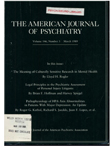A DSM-III family study of the nonschizophrenic psychotic disorders
Abstract
The authors conducted a blind DSM-III family study based on probands diagnosed from long-term follow-up information as having schizophreniform disorder, schizoaffective disorder, or psychotic affective illness. The pattern of psychopathology in relatives of schizophreniform probands closely resembled that found previously in relatives of schizophrenic probands. Relatives of schizoaffective probands had an excess risk for schizophrenia, other psychoses, and bipolar illness. The pattern of illness found in relatives of the probands meeting Research Diagnostic Criteria for mainly schizophrenic schizoaffective disorder appeared indistinguishable from that of relatives of schizophrenic probands. Relatives of probands with psychotic affective disorder had an excess risk for schizophrenia and for unipolar and bipolar affective disorder.
Access content
To read the fulltext, please use one of the options below to sign in or purchase access.- Personal login
- Institutional Login
- Sign in via OpenAthens
- Register for access
-
Please login/register if you wish to pair your device and check access availability.
Not a subscriber?
PsychiatryOnline subscription options offer access to the DSM-5 library, books, journals, CME, and patient resources. This all-in-one virtual library provides psychiatrists and mental health professionals with key resources for diagnosis, treatment, research, and professional development.
Need more help? PsychiatryOnline Customer Service may be reached by emailing [email protected] or by calling 800-368-5777 (in the U.S.) or 703-907-7322 (outside the U.S.).



